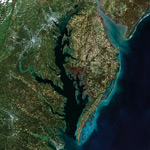
An array of education projects funded by the NOAA Chesapeake Bay-Watershed Education and Training (B-WET) grant program will provide students with opportunities to learn about the Chesapeake Bay ecosystem and how their stewardship of the watershed can help the Chesapeake.
NOAA recently announced the FY20 Notice of Funding Opportunity for the Chesapeake Bay-Watershed Education and Training (B-WET) Program.
Grants awarded this year will either support state efforts toward implementing meaningful watershed educational experiences (MWEEs) across school districts or will develop a network including school districts that provide MWEEs, their partners, and the larger environmental education community.
K-12 public and independent schools and school systems, institutions of higher education, community-based and nonprofit organizations, state or local government agencies, interstate agencies, and Indian tribal governments are eligible to apply. Approximately $400,000 may be available to fund three to five new projects (total amount will depend on appropriations).
The NOAA Chesapeake Bay Office will host informational webinars in January about the FY20 priorities and application process.
Chesapeake B-WET supports environmental literacy in the Chesapeake Bay watershed. Last year’s grants support students and teachers in Pennsylvania, Maryland, and Virginia.
Each of the five projects will run for roughly three years and will support learning both outdoors and in classrooms. Projects also enable professional development opportunities for teachers, giving them the environmental knowledge and science tools they need.
Last year’s grant process focused expanding the reach of B-WET into school districts that had never before received B-WET support. In addition, applicants were encouraged to focus on education about Bay fisheries, to help students understand the ecological, economic, cultural, and recreational importance of Chesapeake Bay fisheries.
In Virginia:
The Elizabeth River Project will partner with Chesapeake Public Schools to engage all fourth graders in intensive study of the Atlantic blue crab, helping those students understand and address the effects of sea level rise on life in the Elizabeth River, themselves, and their community.
The project will reach more than 100 teachers through workshops and 3,000 students over the course of the project. Virginia Commonwealth University with collaborate with Charles City County Public Schools, Colonial Heights Public Schools, New Kent County Public Schools, and Newport News Public Schools to highlight the importance of protecting the watershed along the James River to students.
Using bivalves as a theme, students will learn about connections between riverine and coastal marine ecosystems. Through hands-on field studies, students from diverse backgrounds will investigate and share solutions from their stewardship projects.
In Pennsylvania:
Penn State University will work with the Bald Eagle Area School District to build understanding of watershed dynamics.
Participants will connect activities and action projects in the headwaters with conditions downstream to help build understanding of connections in the watershed and to promote environmental stewardship of the Chesapeake Bay.
In Maryland:
ShoreRivers will partner with Talbot County Public Schools and Dorchester County Public Schools to explore Atlantic sturgeon, an endangered species native to the Chesapeake Bay. Students will research the importance of sturgeon and create an action project based on tracking data, water quality and habitat data, and schoolyard assessments.
Teachers will benefit from professional development during the project. Towson University will partner with Baltimore City Public Schools to build the capacity of all Baltimore City fifth-grade science teachers to facilitate and support student engagement in their meaningful watershed educational experiences.
All students of teachers that participate in the project will visit Baltimore’s Inner Harbor to explore how actions in their schoolyards and communities are connected to and affect the Chesapeake Bay.
source: NOAA Chesapeake Bay Office
Leave a Reply
You must be logged in to post a comment.